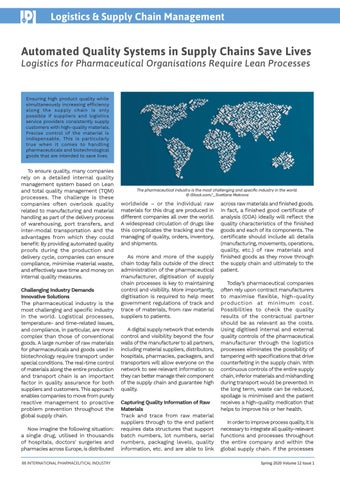Logistics & Supply Chain Management
Automated Quality Systems in Supply Chains Save Lives Logistics for Pharmaceutical Organisations Require Lean Processes
Ensuring high product quality while simultaneously increasing efficiency along the supply chain is only possible if suppliers and logistics service providers consistently supply customers with high-quality materials. Precise control of the material is indispensable. This is particularly true when it comes to handling pharmaceuticals and biotechnological goods that are intended to save lives.
To ensure quality, many companies rely on a detailed internal quality management system based on Lean and total quality management (TQM) processes. The challenge is these companies often overlook quality related to manufacturing and material handling as part of the delivery process of warehousing, port transfers, and inter-modal transportation and the advantages from which they could benefit: By providing automated quality proofs during the production and delivery cycle, companies can ensure compliance, minimise material waste, and effectively save time and money on internal quality measures. Challenging Industry Demands Innovative Solutions The pharmaceutical industry is the most challenging and specific industry in the world. Logistical processes, temperature- and time-related issues, and compliance, in particular, are more complex than those of conventional goods. A large number of raw materials for pharmaceuticals and goods used in biotechnology require transport under special conditions. The real-time control of materials along the entire production and transport chain is an important factor in quality assurance for both suppliers and customers. This approach enables companies to move from purely reactive management to proactive problem prevention throughout the global supply chain. Now imagine the following situation: a single drug, utilised in thousands of hospitals, doctors' surgeries and pharmacies across Europe, is distributed 88 INTERNATIONAL PHARMACEUTICAL INDUSTRY
The pharmaceutical industry is the most challenging and specific industry in the world. © iStock.com/_Svetlana Mokrova
worldwide – or the individual raw materials for this drug are produced in different companies all over the world. A widespread circulation of drugs like this complicates the tracking and the managing of quality, orders, inventory, and shipments. As more and more of the supply chain today falls outside of the direct administration of the pharmaceutical manufacturer, digitisation of supply chain processes is key to maintaining control and visibility. More importantly, digitisation is required to help meet government regulations of track and trace of materials, from raw material suppliers to patients. A digital supply network that extends control and visibility beyond the four walls of the manufacturer to all partners, including material suppliers, distributors, hospitals, pharmacies, packagers, and transporters will allow everyone on the network to see relevant information so they can better manage their component of the supply chain and guarantee high quality. Capturing Quality Information of Raw Materials Track and trace from raw material suppliers through to the end patient requires data structures that support batch numbers, lot numbers, serial numbers, packaging levels, quality information, etc. and are able to link
across raw materials and finished goods. In fact, a finished good certificate of analysis (COA) ideally will reflect the quality characteristics of the finished goods and each of its components. The certificate should include all details (manufacturing, movements, operations, quality, etc.) of raw materials and finished goods as they move through the supply chain and ultimately to the patient. Today’s pharmaceutical companies often rely upon contract manufacturers to maximise flexible, high-quality production at minimum cost. Possibilities to check the quality results of the contractual partner should be as relevant as the costs. Using digitised internal and external quality controls of the pharmaceutical manufacturer through the logistics processes eliminates the possibility of tampering with specifications that drive counterfeiting in the supply chain. With continuous controls of the entire supply chain, inferior materials and mishandling during transport would be prevented. In the long term, waste can be reduced, spoilage is minimised and the patient receives a high-quality medication that helps to improve his or her health. In order to improve process quality, it is necessary to integrate all quality-relevant functions and processes throughout the entire company and within the global supply chain. If the processes Spring 2020 Volume 12 Issue 1
























